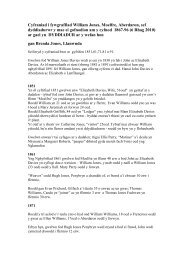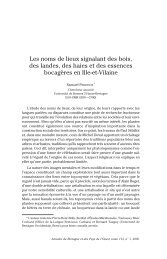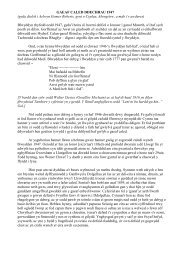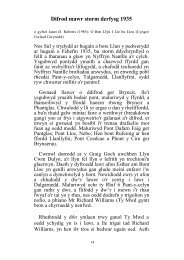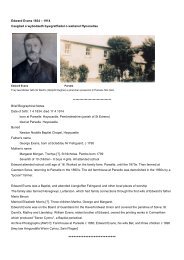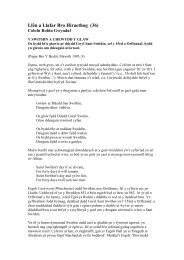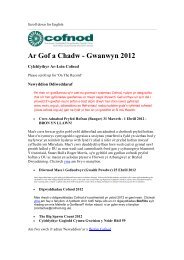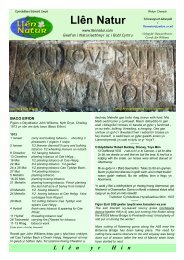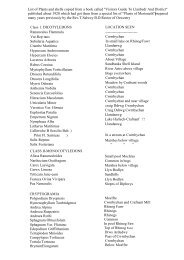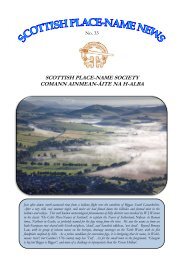Ceulan. — This <strong>place</strong> derives its name from <strong>the</strong> river Ceulan that flows through it. Tradition po<strong>in</strong>ts to this<strong>place</strong> as Talies<strong>in</strong>'s <strong>place</strong> <strong>of</strong> sepulture. English name — Bankham.Cilcen<strong>in</strong>. — Cil, a <strong>place</strong> <strong>of</strong> retreat; Cenn<strong>in</strong>, a corrupted form <strong>of</strong> St. Cannen, to whose memory <strong>the</strong> parishchurch is dedicated. English name — Cannenchurch.Clarach. — This <strong>place</strong> takes its name from <strong>the</strong> river Clarach, near which it is situated. Clar-clatr, clear; ach,river. English name — Clearwater.Croes. — This <strong>place</strong> takes its name from <strong>the</strong> river Croes, which signifies cross. English name — Crossby.Cwm Barre. — A valley through which <strong>the</strong> river Barre flows. Bar, a limit; re, a corruption <strong>of</strong> rau, pluralis<strong>in</strong>gbar. The river is <strong>the</strong> boundary between some parts <strong>of</strong> <strong>the</strong> parishes <strong>of</strong> Troedyraur <strong>and</strong> Penbryn. Barry issupposed to have come from <strong>the</strong> same root. English name — Limit Vale.Cwm Rheidiol. — Cwm, a low <strong>place</strong> surrounded by hills; Rheidiol, <strong>the</strong> name <strong>of</strong> <strong>the</strong> river that flows through it,which is a contraction <strong>of</strong> rhyd-y-ddol, <strong>the</strong> stream <strong>of</strong> <strong>the</strong> meadow. English name — Moorcombe.Dihewyd. — A mutation <strong>of</strong> Dehau-wydd. Dehau, south; gwydd, <strong>the</strong> state <strong>of</strong> be<strong>in</strong>g <strong>in</strong> view. Gwyddfod meanspresence. There is a hill called Moel Dihewyd <strong>in</strong> <strong>the</strong> parish, so called from its sou<strong>the</strong>rn aspect. English name— Southview.Dothi-Camddwr. — Dothi, a corrupted form <strong>of</strong> iowyddu, which implies swell<strong>in</strong>g; Camddwr, <strong>the</strong> crookedwater, <strong>the</strong> name <strong>of</strong> <strong>the</strong> river that flows through <strong>the</strong> <strong>place</strong>, so called from its me<strong>and</strong>er<strong>in</strong>g course. English name— Crookby.Ferwig. — Berw, a boil<strong>in</strong>g, an ebullition; wig, <strong>in</strong>flection <strong>of</strong> gwig, a grove, a nook. The right orthography isBetwig, which, accord<strong>in</strong>g to some, is cognate with Berwick <strong>and</strong> o<strong>the</strong>r <strong>place</strong>s <strong>in</strong> Engl<strong>and</strong>. From its contiguityto <strong>the</strong> sea, its English name would be Grovesea,Gar<strong>the</strong>li. — A corrupted form <strong>of</strong> Gwr<strong>the</strong>li, <strong>the</strong> name <strong>of</strong> <strong>the</strong> sa<strong>in</strong>t who founded a chapel <strong>in</strong> <strong>the</strong> <strong>place</strong>. Englishname — Gwr<strong>the</strong>li.Hawen. — The village takes its name from <strong>the</strong> river Hawen. Hawen is a compound <strong>of</strong> aw, a mov<strong>in</strong>g agent,water, <strong>and</strong> an or a<strong>in</strong>, brook, signify<strong>in</strong>g <strong>the</strong> runn<strong>in</strong>g stream. English name — Brookham.Henbel<strong>in</strong>. — A corrupted form probably <strong>of</strong> Henfel<strong>in</strong>, old mill. English name — Oldmill.Henfynyw. — The name signifies " Old Menevia." Tradition has it that <strong>the</strong> ca<strong>the</strong>dral <strong>of</strong> St. David's was<strong>orig<strong>in</strong></strong>ally designed to have been erected here. This parish is famous for be<strong>in</strong>g <strong>the</strong> <strong>place</strong> where <strong>the</strong> patronsa<strong>in</strong>t <strong>of</strong> Wales spent his earlier days. A spr<strong>in</strong>g that is near <strong>the</strong> church is still called Ffynon Ddewi, St. David'sWell.Henllan. — The name signifies old church, <strong>and</strong> it po<strong>in</strong>ts out <strong>the</strong> great antiquity <strong>of</strong> <strong>the</strong> <strong>orig<strong>in</strong></strong>al edifice <strong>of</strong> thisparish. English name- -Oldchurch.Henllys. — Hen, old; llys, court, hall, or seat, signify<strong>in</strong>g <strong>the</strong> ancient hall. Henllys <strong>and</strong> Gadlys are found to bevery numerous <strong>in</strong> Wales, as traces <strong>of</strong> <strong>the</strong> battles fought by <strong>the</strong> Welsh pr<strong>in</strong>ces. English name — Oldhall.Llananerch. — A compound <strong>of</strong> Llan <strong>and</strong> llanerch, an enclosure, <strong>and</strong> sometimes <strong>the</strong> latter signifies a ris<strong>in</strong>gem<strong>in</strong>ence. English name — Churchill.Llanarth. — Arth here means a bear, accord<strong>in</strong>g to some. The general op<strong>in</strong>ion <strong>of</strong> <strong>the</strong> <strong>in</strong>habitants is that bearsexisted here at some remote period. It is hardly credible that <strong>the</strong> sa<strong>in</strong>tly Cymry would do <strong>the</strong> bear such anhonour as to couple his name with <strong>the</strong> sacred edifice. We derive <strong>the</strong> name from Llan, church ; <strong>and</strong> garth, ahill, <strong>and</strong> sometimes enclosure. English name — Risechurch.Llanbadarn. — The church is dedicated to Padarn, who, accord<strong>in</strong>g to Usher, was an Armorican bishop, <strong>and</strong>came to Wales with his cous<strong>in</strong> Cadven <strong>in</strong> 516. He left Illtyd's sem<strong>in</strong>ary for Ceredigion, <strong>and</strong> ga<strong>the</strong>red acongregation <strong>of</strong> 120 members at a <strong>place</strong> called afterwards Llanbadarn Fawr. The differentia fawr was addedOrig<strong>in</strong> <strong>of</strong> Place-<strong>names</strong> <strong>in</strong> Wales & Monmouthshire Page 27
to mark its pre-em<strong>in</strong>ence over <strong>the</strong> o<strong>the</strong>r parishes <strong>of</strong> <strong>the</strong> same name, <strong>and</strong> to dist<strong>in</strong>guish it from <strong>the</strong> adjacenttown <strong>of</strong> Aberystwyth, which was anciently called Llanbadarn Gaerog. English name — Bishop Padarn.Llanbedr-pont-Stephan. — The popular English name is Lampeter, which is an Anglicized form <strong>of</strong> Llanbedr.We f<strong>in</strong>d many churches <strong>in</strong> Wales bear<strong>in</strong>g <strong>the</strong> name Pedr, Peter, but who this Peter was is a matter <strong>of</strong>conjecture. Most writers po<strong>in</strong>t to Peter <strong>the</strong> Apostle. From a certa<strong>in</strong> document <strong>the</strong> pont, bridge, appears tohave been erected early <strong>in</strong> <strong>the</strong> fifteenth century. " Rhys, <strong>the</strong> son <strong>of</strong> David ap Rhys, <strong>of</strong> Pencarreg, marriedLleuan, daughter <strong>of</strong> Ieuan David Llwyd ap David Ddu ap David Decka ap Steven, <strong>the</strong> man who erectedLampeter bridge at his own expense" English name — Peterschurch.Ll<strong>and</strong>a<strong>in</strong> Fach. — Da<strong>in</strong> means beautiful, f<strong>in</strong>e; fach, little. The name signifies <strong>the</strong> beautiful little church.English name — Little Church, or Beauchurch.Ll<strong>and</strong>egwy. — Tegwy was a sa<strong>in</strong>t <strong>of</strong> <strong>the</strong> sixth century, <strong>and</strong> a descendant <strong>of</strong> Nudd Hael. The above churchwas dedicated to him. English name — Fairchurch.Ll<strong>and</strong>ysiliogogo. — St. Tysilio, a bishop <strong>and</strong> an em<strong>in</strong>ent author, who flourished about <strong>the</strong> middle <strong>of</strong> <strong>the</strong>seventh century. Brut Tysilio, a copy <strong>of</strong> which is <strong>in</strong> <strong>the</strong> Myv. Arch. <strong>and</strong> is attributed to him. He was <strong>the</strong> patronsa<strong>in</strong>t <strong>of</strong> many churches <strong>in</strong> Wales. The differentia gogo is a mutation <strong>of</strong> gog<strong>of</strong>au, caves, which are verynumerous <strong>in</strong> <strong>the</strong> parish. English name — Caveham.Ll<strong>and</strong>ysul. — Tysul, a descendant <strong>of</strong> Cunedda Wledig, <strong>and</strong> a sa<strong>in</strong>t <strong>of</strong> <strong>the</strong> sixth century, to whom <strong>the</strong> abovechurch was dedicated. English name — Tysul.Ll<strong>and</strong>de<strong>in</strong>iol. — De<strong>in</strong>iol Wyn, or Daniel, assisted his fa<strong>the</strong>r, Dunawd Fur, <strong>in</strong> found<strong>in</strong>g <strong>the</strong> celebratedmonastery at Bangor Iscoed, <strong>and</strong> he founded several churches, <strong>of</strong> which Ll<strong>and</strong>de<strong>in</strong>iol is reckoned to be one;hence <strong>the</strong> name. English name — St. Daniel.Ll<strong>and</strong>dewi-Aberarth. — The church was dedicated to Dewi, <strong>the</strong> patron sa<strong>in</strong>t <strong>of</strong> Wales. Aber, estuary; Arth,<strong>the</strong> name <strong>of</strong> <strong>the</strong> river, near <strong>the</strong> mouth <strong>of</strong> which <strong>the</strong> village is situated. Arth signifies rough, harsh. Englishname — Roughton.Ll<strong>and</strong>dewi-Brefi. — Brefi means bellow<strong>in</strong>g. The traditional ox overstra<strong>in</strong>ed himself <strong>in</strong> endeavour<strong>in</strong>g to draw<strong>the</strong> avane (beaver) from <strong>the</strong> lake, <strong>and</strong> suddenly expired. The o<strong>the</strong>r, hav<strong>in</strong>g lost his yoke-fellow, would not beconsoled, refused food, <strong>and</strong> w<strong>and</strong>ered about until he died <strong>in</strong> a <strong>place</strong> called Brefi, so called from <strong>the</strong> dismalmoans <strong>of</strong> <strong>the</strong> sacred animal. Dewi, <strong>the</strong> patron sa<strong>in</strong>t <strong>of</strong> Wales, founded a church <strong>and</strong> a religious sem<strong>in</strong>ary on<strong>the</strong> spot; hence Ll<strong>and</strong>dewi-Brefi. English name — Moanham.Ll<strong>and</strong>dyfriog. — Tyfriog, a sa<strong>in</strong>t who flourished about <strong>the</strong> close <strong>of</strong> <strong>the</strong> sixth century, founded <strong>the</strong> church.English name — Tyvriog.Llanfair. — The church was dedicated to St. Mary; hence <strong>the</strong> name <strong>of</strong> <strong>the</strong> little village would be St. Mary'sChurch.Llanfihangel Castell Gwallter. — The church was dedicated to St. Michael. Walter l'Espec built a castle ona hill near <strong>the</strong> church dur<strong>in</strong>g <strong>the</strong> Norman conquest gives <strong>the</strong> additional name. Omitt<strong>in</strong>g <strong>the</strong> first portion <strong>of</strong> <strong>the</strong>name, <strong>the</strong> English name is – Walter's Castle.Llanfihangel Lledrod. — The church is dedicated to Lledrod which is a compound <strong>of</strong> lleth, a slope, <strong>and</strong> rod,a base; <strong>the</strong> church be<strong>in</strong>g built at <strong>the</strong> foot <strong>of</strong> a hill. - English name — Foothill.Llanfihangel -y-Creuddyn. — The church is dedicated to ???? <strong>and</strong> ???hael. Lewis Morris derives Cmiddyn;<strong>and</strong> dun, a fort, signify<strong>in</strong>g a bloody battle a commot <strong>of</strong> <strong>the</strong> same name nearby: <strong>the</strong> <strong>the</strong> castle <strong>of</strong> Dyganwywas situated, English k<strong>in</strong>gs, John <strong>and</strong> Henry III., had pursued <strong>the</strong>ir fruitless expeditions aga<strong>in</strong>st <strong>the</strong> ???iEnglish name — Churchfort.?????. — St. Ceitho. who flourished <strong>in</strong> <strong>the</strong> <strong>in</strong>ded <strong>the</strong> church, which was dedicated to ??? English name —Ceitho.Note for Readers:A number <strong>of</strong> <strong>place</strong>-<strong>names</strong> are omitted here. Faulty scann<strong>in</strong>g encountered.Orig<strong>in</strong> <strong>of</strong> Place-<strong>names</strong> <strong>in</strong> Wales & Monmouthshire Page 28
- Page 1 and 2: HANDBOOK OF THE ORIGIN OF PLACE-NAM
- Page 3 and 4: § § § § §The Author begs to st
- Page 5 and 6: pitiful cries of the railway offici
- Page 7 and 8: Bishop Percy says that "in England,
- Page 9 and 10: The city of Chester is still popula
- Page 11 and 12: There's Cumwhitton, Cumwhinton, Cum
- Page 13 and 14: Llwyn in its primary' sense means a
- Page 15 and 16: PLACE-NAMES IN WALES.Wales. — The
- Page 17 and 18: Church are generally dedicated to e
- Page 19 and 20: think he was a contemporary of St.
- Page 21 and 22: Rhosbeirio. — Rhos, a moor, a dry
- Page 23 and 24: of Brecknock," states that this vic
- Page 25 and 26: Cam cnwir ef Cwmdu,Cwm gwyn yw & n
- Page 27 and 28: Penderyn. — A corruption probably
- Page 29: Ardudwy. — Ar, upon or above; tud
- Page 33 and 34: Some think that eirw is a corruptio
- Page 35 and 36: present form — Caerfyrddin.Abergw
- Page 37 and 38: place of refuge; hence the name. En
- Page 39 and 40: Llansawyl. — The church was dedic
- Page 41 and 42: eject. The village took its name fr
- Page 43 and 44: house, and attempted to kill an inf
- Page 45 and 46: Gwydir. — Prima facie one may tak
- Page 47 and 48: Nefyn. — The church was probably
- Page 49 and 50: DENBIGHSHIRE.Anglicized form of Din
- Page 51 and 52: Llangollen. — From Collen, a sain
- Page 53 and 54: hands into their pockets to pay a c
- Page 55 and 56: Cefn. — The name signifies a ridg
- Page 57 and 58: Maesgarmon. — Named in honour of
- Page 59 and 60: Abertridwr. — Tridwr, three water
- Page 61 and 62: it is said, was originally built by
- Page 63 and 64: Cwmllynfell. — Cwm, a narrow vale
- Page 65 and 66: Gwarycaeau. — Gwdr, the nape of t
- Page 67 and 68: means a cultivated region, a vale,
- Page 69 and 70: Penrhiwfer.- Pen, head, top; rhiw,
- Page 71 and 72: Port Talbot. — So called in 1835
- Page 73 and 74: Trealaw. — This appellation was g
- Page 75 and 76: Aberdyfi. — So called from its si
- Page 77 and 78: Llanddwywe. — From Dwywau, a desc
- Page 79 and 80: Crickhowell and some in the directi
- Page 81 and 82:
Griffithstown. — This village was
- Page 83 and 84:
and gwy, water. Treiddiod troth tna
- Page 85 and 86:
derive Tintern from din, fortified
- Page 87 and 88:
Caersws. — It appears that the Ro
- Page 89 and 90:
English name — Ervylton.Llanymech
- Page 91 and 92:
Angle. — Probably from the angle-
- Page 93 and 94:
Gellyswick. — Another hybrid. Gel
- Page 95 and 96:
that the two rivers in their flowin
- Page 97 and 98:
ecame the bishop of the see, and wa
- Page 99 and 100:
earth formerly stood on a summit on
- Page 101 and 102:
Pilleth. — A corruption of pwll,
- Page 103 and 104:
Howells, Rev. J., Mountain AshHowel
- Page 105 and 106:
Williams, D., PenywernWilliams, Rev



